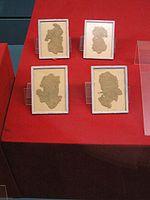The Four Great Inventions
2009-09-14 16:50 BJT
China's long history has seen some extremely important inventions emerge, most noticeably gunpowder, paper making, printing and the compass, which, in the words of Roger Bacon, changed the whole appearance and status of things in the world.
 |
| Hemp wrapping paper, China, circa 100 BC |
China was the first country in the world to make proper paper. Paper made during the Western Han Dynasty (202 BC-16 AD) has been found in Gansu Province, Xi'an and other places in Shaanxi Province as well as Xinjiang. A further development of paper is credited to Cai Lun of the Eastern Han (25-220). He used plant fiber such as tree bark, bits of rope, rags and worn-out fishing nets as raw materials. In 105, Cai presented the first batch of paper made under his supervision to the Han emperor, who was so delighted that he named the material "Marquis Cai's paper". Eastern Han Dynasty paper found in Wuwei, Gansu, in 1974 carried words which were still clearly decipherable. Thin, soft, and with a smooth finish and tight texture, this paper is the most refined and oldest paper discovered to date.
Before paper was invented, the ancient Chinese carved characters on pottery, animal bones and stones, cast them on bronzes, or wrote them on bamboo or wooden strips and silk fabric. These materials, however, were either too heavy or two expensive for widespread use. The invention and use of paper brought about a revolution in writing materials, paving the way for the invention of printing technology in the years to come.
 |
| Handgun from the Yuan dynasty, circa 1300s. |
The invention of gunpowder was no doubt one of the most significant achievements of the Middle Ages in China. The correct prescription for making gunpowder with nitre, sulphur and carbon was probably discovered in the ninth century. In fact, in his book, Ge Hong in the third century records the procedures for making a kind of mixture that could be ignited. After the Tang Dynasty (618-907), things took a much faster course as gunpowder was already used in simple hand-grenades which were thrown by a catapult. In 1126, Li Gang, a local official, recorded how he ordered the defenders of the city of Kaifeng to "fire cannons" at the invading Nuzhen tribal people, inflicting heavy casualties on the invaders.

 Mail
Mail Share
Share Print
Print


 Video
Video









 2009 China Central Television. All Rights Reserved
2009 China Central Television. All Rights Reserved